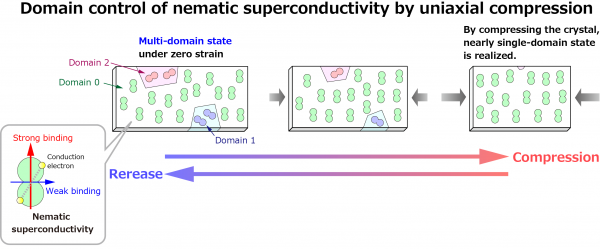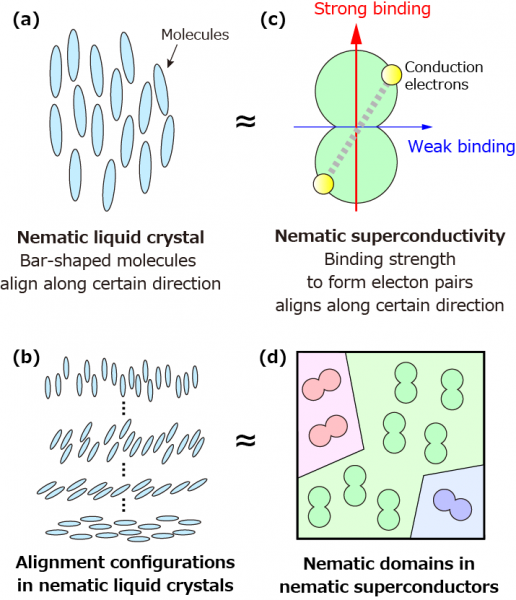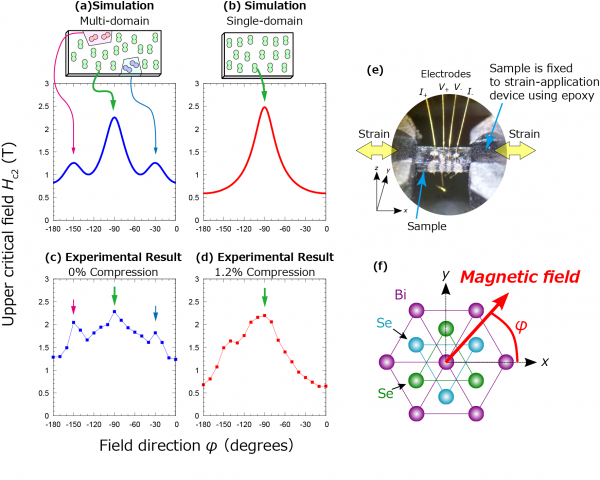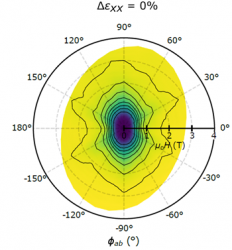In consumer liquid-crystal displays, “nematic” liquid-crystals, in which bar-shaped molecules align along a certain direction, are utilized. Configuration of this molecular alignment can be controlled by an applied voltage, to change the light transparency of each pixel. Recently, “nematic superconductivity”, which is analogous to nematic liquid-crystals, has been discovered. Superconductivity, the phenomenon characterized by the total disappearance of electrical resistivity, is caused by quantum-mechanical binding of two conduction electrons, resulting in formation of electron pairs. In nematic superconductors, the electron pairs align by themselves in a way that the binding strength becomes strong along a certain direction.
Therefore, an interesting question arises: is it possible to control and utilize these aligned electron pairs? We succeeded in controlling the alignment configuration of the nematic electron pairs by squeezing a nematic superconductor along one direction. More concretely, by applying and releasing compression to a crystal of the bismuth-selenium-based superconductor, multiple regions (domains) of different electron pair alignment were repeatably changed between a single-domain and multi-domain state. Such control of superconductivity via its domain structure has never been achieved in the over-100-year history of the research of superconductivity. It is expected that this work can trigger wide research developments that can be termed as “superconducting domain engineering”.
This work has been published in Nature Communications on 24th Aug. 2020. https://www.nature.com/articles/s41467-020-17913-y
Moreover, this paper is selected for Editors’ Highlights on condensed-matter physics: https://www.nature.com/collections/rcdhyvxytb , where only a few articles per month on condensed-matter physics are highlighted as interesting and important works.

Introduction
In modern liquid-crystal displays (LCDs), nematic liquid-crystals, in which bar-shaped molecules align along a certain direction while keeping fluidity, is used. The direction of the molecular alignment can be controlled by an applied voltage. Across a larger length scale, the alignment direction can vary gradually, and overall the liquid-crystals can form various alignment configurations. In each pixel of an ordinary LCD, a twisting structure of the molecular alignment is realized. By an applied voltage, such twisting is released, and the light transmission is varied. In this way, control of large-scale alignment configuration enables the display of videos or photos.
Recently, the superconductor counterpart of nematic liquid-crystals, namely the nematic superconductors, have been discovered among bismuth-selenium-based superconductors. The present research group made a large contribution in this discovery and establishment of nematic superconductivity. Superconductivity, the total disappearance of electrical resistivity, was discovered 100-years before, and now it is revealed that the formation of pairs among conduction electrons is the fundamental origin. In any superconductor, the binding strength of this pair formation has been known to have its anisotropy match, at most, with the anisotropy of the crystal-lattice structure of the superconductor. In contrast, the recently found nematic superconductors have stronger binding along a specific crystallographic direction, than the other equivalent directions. This situation resembles the nematic liquid-crystals.

In order to consider possible alignment configuration in nematic superconductors, one should carefully take into account the crystalline lattice. In liquid-crystals, the molecules can align along any directions, if strong influences by the wall of the container do not exist. In contrast, nematic superconductors, because of the crystal-lattice, which serves as a background of moving conduction electrons, the electron pairs can align only along particular crystalline directions. In case of the bismuth-selenium superconductors, the crystal structure possesses three equivalent directions, and the electron-pair alignment is only possible along these three directions. Thus, the twisting structure that is often achieved in liquid-crystals cannot be realized in nematic superconductors. Instead, regions with certain alignment directions, called as domains, can co-exist within the sample. Such multi-domain structure is the fundamental alignment configuration in the nematic superconductors.
Then, it is an interesting question whether the nematic superconductivity, and particularly its domain structures, have controllability like that of nematic liquid-crystals. Since superconductors have no resistivity, voltage cannot be applied and hence voltage control is hopeless. Instead, it has been theoretically suggested that lattice deformation (strain) can affect nematic superconductivity. However, this prediction needs verifications based on experiments. Moreover, the strain effect to a multi-domain situation has not been considered at all, and hence requires experimental clarifications.
Method and Results
In this project, we studied external-strain control of nematic superconductivity. Single-crystalline samples of SrxBi2Se3 (x is the doping amount of Sr; in this work, x is estimated to be 0.06), grown by Prof. Yoichi Ando’s group in Univ. of Cologne, Germany, was mounted onto a strain-application apparatus, which utilizes the piezo-electric devices. The anisotropy in the binding strength of nematic electron pairs has been investigated via the anisotropy of the upper critical field, the field that is required to break superconductivity. For a single-domain nematic superconductor, a two-fold anisotropic behavior in the angular dependence of the upper critical field is expected. In contrast, for a multi-domain sample, more complicated patterns resulting from the combination of multiple two-fold behaviors are expected. The important feature of this multi-domain behavior is that peaks in the upper critical field can be observed in the interval of 60 degrees, each peak reflecting the nematic-pair alignment.
We succeeded in controlling nematic superconductivity, in particular its domain configuration, by using externally applied strain. As shown in the figure below, we revealed that the upper critical field, the magnetic field required to suppress superconductivity, exhibits complicated multi-peak pattern as a function of field angle under zero external strain, but it exhibit a simple two-fold structure when the sample is compressed by about 1%. The former agrees with an expectation for multi-domain situation, and the latter for single-domain situation. Moreover, these two domain configurations can be repeatably changed back and forth by releasing and applying the strain.

Implications
Domains are known to be realized in ferromagnets, such as iron. By changing the domain structure, the magnetic behavior of, for example, an iron nail, can be largely altered. Thus, domain control is fundamentally important for technological utilization of ferromagnets. More recently, the microscopic utilization of magnetic domains, domain engineering, has been widely tested, and several technologies such as racetrack memory are getting closer to consumer use.
In the present work, the theoretically predicted control of the domains of nematic superconductivity by external strain has been experimentally confirmed for the first time. Such control of superconducting properties via domain configuration has not been reported during the long history of research in superconductivity. This discovery may trigger new research developments that can be termed as “superconducting domain engineering” in both basic and applied sciences.
Paper information
Uniaxial-strain control of nematic superconductivity in SrxBi2Se3
Ivan Kostylev*, Shingo Yonezawa*, Zhiwei Wang, Yoichi Ando, Yoshiteru Maeno (* Corresponding authors)
Nature Communications, 11, 4152 (2020)
https://www.nature.com/articles/s41467-020-17913-y
![]()
